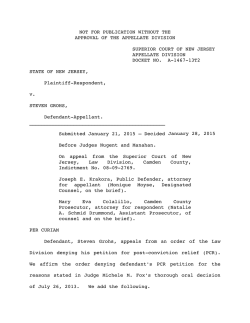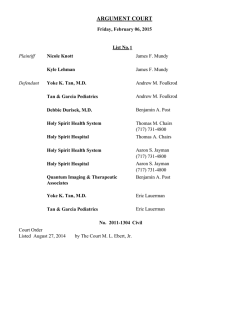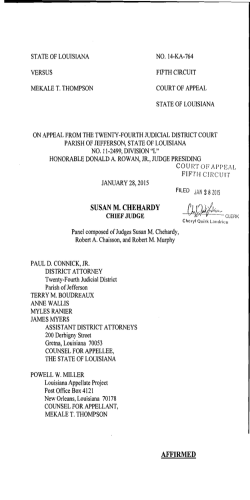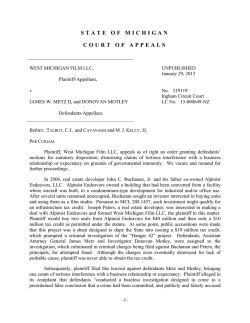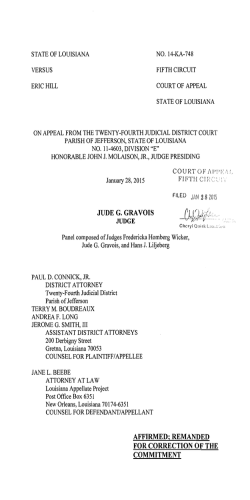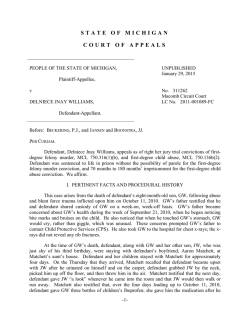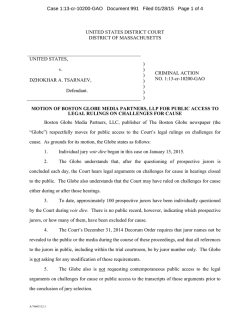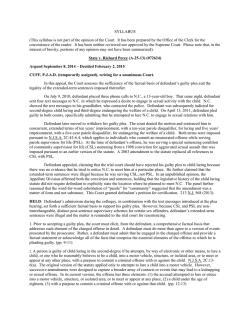
Unpublished 01/28/2015
STATE OF MICHIGAN COURT OF APPEALS PEOPLE OF THE STATE OF MICHIGAN, UNPUBLISHED January 29, 2015 Plaintiff-Appellee, v No. 314684 Oakland Circuit Court LC No. 2011-238692-FC JEFFREY BERNARD PYNE, Defendant-Appellant. Before: OWENS, P.J., and JANSEN and O’CONNELL, JJ. PER CURIAM. Defendant appeals by right his jury-trial conviction of second-degree murder,1 MCL 750.317, for which he was sentenced to 20 to 60 years in prison. We affirm. Defendant’s conviction arises from the bludgeoning and stabbing death of his 51-year-old mother, Ruth Pyne (Ruth), at their house in Highland Township, Michigan, on May 27, 2011. Evidence indicated that defendant and his mother had a tumultuous relationship, fueled by his mother’s failure to take her medication for bipolar disorder. The prosecutor’s theory at trial was that defendant had become increasingly frustrated about living with his mother’s mental illness, and that other events in the months preceding the crime contributed to defendant’s emotional state that led to the violent attack. On the afternoon of May 27, 2011, at approximately 2:30 p.m., defendant’s father returned home and found Ruth lying in a pool of blood in the garage. He contacted the police. Ruth had a large wound on the back of her skull and multiple stab wounds on her neck. The front door was locked with a deadbolt and there were no signs of forced entry, theft, or a struggle inside the house. Bloodstains on the garage door indicated that the garage door was closed at the time of the incident. After finding Ruth’s body, defendant’s father summoned defendant, who was working at his job at an apple orchard. When defendant arrived home, he had bandages that covered blistering injuries on his hands. Defendant claimed that he received the injuries at work while handling a wooden pallet. The prosecutor theorized that defendant’s injuries were 1 The jury acquitted defendant of an original charge of first-degree premeditated murder, MCL 750.316(1)(a). -1- inconsistent with his explanation and had instead resulted from repeatedly swinging the murder weapon. Defendant told the police that his mother was lying in her bed when he left home at 1:30 p.m. to perform yard work for someone before going to the orchard where he was scheduled to begin work at 3:00 p.m.2 The defense theory at trial was that defendant was not at home when Ruth was killed, and that there was no direct evidence connecting him to his mother’s death. I. ADMISSION OF EVIDENCE Defendant first argues that the trial court erred by allowing the prosecutor to elicit improper character, opinion, and irrelevant evidence, contrary to MRE 404(b) and MRE 403.3 We disagree. Defendant objected to (1) the prosecutor asking defendant’s coworker, Nicholas Bretti, if defendant’s injuries could have been made by picking up wooden pallets; (2) the prosecutor asking Bretti what happened between defendant and defendant’s former girlfriend, Holly Freeman; (3) the prosecutor asking Bretti about defendant’s alcohol consumption; and (4) the prosecutor asking Freeman about what happened in her relationship with defendant and whether defendant cheated on her. Therefore, those evidentiary claims are preserved. Defendant did not object, however, to (1) the prosecutor asking defendant’s boss, William Cartwright, if defendant’s explanation of his hand injuries made sense; (2) the prosecutor asking the two responding EMS workers and police officers if defendant’s reaction after hearing about his mother’s death was sincere; (3) the prosecutor asking Bretti whether defendant was drunk; (4) the prosecutor asking officers their opinions about certain aspects of the crime scene; and (5) Freeman’s testimony that defendant had cheated on her and had started to lie effortlessly. Therefore, those evidentiary claims are not preserved for appellate review. We review a trial court’s decision to admit evidence for an abuse of discretion. People v Feezel, 486 Mich 184, 192; 783 NW2d 67 (2010). A decision on a close evidentiary question ordinarily cannot be an abuse of discretion. People v Sabin (After Remand), 463 Mich 43, 67; 614 NW2d 888 (2000). “A trial court abuses its discretion when its decision falls ‘outside the range of principled outcomes.’” Feezel, 486 Mich at 192 (citation omitted). If there is an underlying question of law, such as whether admissibility is precluded by a rule of evidence, that question is reviewed de novo. People v McDaniel, 469 Mich 409, 412; 670 NW2d 659 (2003). Defendant’s unpreserved claims of evidentiary error are reviewed for plain error affecting defendant’s substantial rights. People v Carines, 460 Mich 750, 763-764; 597 NW2d 130 (1999). A. OTHER ACTS EVIDENCE We disagree with defendant’s argument that evidence of his prior acts and conduct was inadmissible under MRE 404(b). MRE 404(b)(1) prohibits “evidence of other crimes, wrongs, or acts” to prove a defendant’s character or propensity to commit the charged crime, but permits 2 The homeowner in question denied that defendant performed yard work for her that day. She testified that the yard work was completed days earlier. 3 Defendant also cites MRE 404(a) in his general discussion. -2- such evidence for other purposes “such as proof of motive, opportunity, intent, preparation, scheme, plan, or system in doing an act, knowledge, identity, or absence of mistake or accident when the same is material.” See People v Knox, 469 Mich 502, 509; 674 NW2d 366 (2004). “At its essence, MRE 404(b) is a rule of inclusion, allowing relevant other acts evidence as long as it is not being admitted solely to demonstrate criminal propensity.” People v Martzke, 251 Mich App 282, 289; 651 NW2d 490 (2002); see also People v Mardlin, 487 Mich 609, 615; 790 NW2d 607 (2010). Other acts evidence is admissible under MRE 404(b)(1) if it is (1) offered for a proper purpose, i.e., one other than to prove the defendant’s character or propensity to commit the crime, (2) relevant to an issue or fact of consequence at trial, and (3) sufficiently probative to outweigh the danger of unfair prejudice, pursuant to MRE 403. People v Starr, 457 Mich 490, 496-497; 577 NW2d 673 (1998); People v VanderVliet, 444 Mich 52, 55, 63-64, 74-75; 508 NW2d 114 (1993), amended 445 Mich 1205 (1994). Defendant challenges the prosecutor’s elicitation of testimony about the demise of defendant’s relationship with his former girlfriend because of his cheating and lying, and his consumption of alcohol, essentially arguing that the evidence was not within the purview of MRE 404(b) because it did not demonstrate any similar acts of violence. Although MRE 404(b) provides examples of permissible uses of other acts evidence, the list is not exhaustive. People v Watson, 245 Mich App 572, 576-577; 629 NW2d 411 (2001). Contrary to defendant’s assertions, the rule permits the admission of evidence of a defendant’s prior acts for any relevant purpose that “‘does not risk impermissible inferences of character to conduct.’” Id. at 576 (citation omitted). The challenged evidence was relevant to factual issues in this case and was not offered to show propensity. “A trial court admits relevant evidence to provide the trier of fact with as much useful information as possible.” People v Cameron, 291 Mich App 599, 612; 806 NW2d 371 (2011). We agree with the prosecution that the challenged evidence was relevant to its theory that defendant began a “downward spiral” in the months preceding his mother’s death, which culminated in a state of mind that led him to kill his mother. The prosecutor theorized that although Ruth’s mental illness presented a challenge for defendant, defendant had been an ideal boyfriend, employee, and friend before March 2011. The challenged testimony revealed that beginning in March 2011, within two months of his mother’s death, defendant began to act differently around his girlfriend, friends, and coworkers. The prosecutor theorized that defendant became distraught after his girlfriend broke up with him, and that defendant’s level of frustration was exasperated by his father deciding not to divorce his mother, causing defendant to ultimately take out his frustration and despair on his mother. The challenged evidence provided context for the jury to understand how defendant’s mentality could have deteriorated to a point that would have caused him to violently attack his mother. Further, we are not persuaded that the evidence should have been excluded under MRE 403. MRE 403 is not intended to exclude “damaging” evidence, because any relevant evidence will be damaging to some extent. People v Mills, 450 Mich 61, 75; 537 NW2d 909 (1995), mod 450 Mich 1212 (1995). Instead, under the balancing test of MRE 403, a court must first decide whether the evidence is unfairly prejudicial, and then “‘weigh the probativeness or relevance of the evidence’ against the unfair prejudice” to determine whether any prejudicial effect substantially outweighed the probative value of the evidence. Cameron, 291 Mich App 611 (citation omitted). Unfair prejudice exists where there is “‘a danger that marginally probative -3- evidence will be given undue or pre-emptive weight by the jury’” or “‘it would be inequitable to allow the proponent of the evidence to use it.’” Mills, 450 Mich at 75-76 (citation omitted); see also People v McGuffey, 251 Mich App 155, 163; 649 NW2d 801 (2002). In the second situation, the unfair prejudice language “refers to the tendency of the proposed evidence to adversely affect the objecting party’s position by injecting considerations extraneous to the merits of the lawsuit, e.g., the jury’s bias, sympathy, anger, or shock.” Cameron, 291 Mich App 611 (quotation marks and citations omitted). Although defendant asserts that the evidence is inherently prejudicial, we are not persuaded that the jury would not have been able to rationally weigh the evidence. Under the circumstances, the trial court’s decision to allow the evidence did not fall outside the range of reasonable and principled outcomes, Feezel, 486 Mich at 192, and its introduction did not constitute plain error, Carines, 460 Mich at 752-753. B. LAY OPINION TESTIMONY Defendant also argues that several witnesses who were not qualified as experts under MRE 702 were allowed to provide improper opinion testimony. We disagree. MRE 701 permits lay witnesses to provide testimony in the form of an opinion if the opinion is “(a) rationally based on the perception of the witness and (b) helpful to a clear understanding of the witness’ testimony or the determination of a fact in issue.” But “a witness cannot express an opinion on the defendant’s guilt or innocence of the charged offense.” People v Fomby, 300 Mich App 46, 53; 831 NW2d 887 (2013) (quotation marks and citation omitted). Courts have liberally applied MRE 701 in order to help develop a clearer understanding of facts for the trier of fact. People v Oliver, 170 Mich App 38, 50; 427 NW2d 898 (1988), mod on other grounds 433 Mich 862 (1989). Thus, a lay witness may offer an opinion on matters that are related to her observations and findings and are not overly dependant upon scientific, technical, or other specialized knowledge. See id.; see also People v McLaughlin, 258 Mich App 635, 657-659; 672 NW2d 860 (2003). 1. OPINIONS ABOUT DEFENDANT’S INJURIES Defendant claimed that the injuries to his hand occurred at work when moving a wooden pallet. Cartwright, the market manager at the apple orchard where defendant was employed, had worked at the farm for 25 years and had thrown hundreds of pallets. He testified that, based on his experience, defendant’s explanation about his injuries “didn’t make sense” because he had never seen a pallet cause that type of injury. Bretti had worked at the orchard with defendant for three years and had handled pallets “[h]undreds of times” since 2009. Based on his experience, Bretti did not see any way a pallet would made that type of injury. Both witnesses based their opinions on their own perceptions of defendant’s injuries and their years of personal experience handling pallets. The challenged opinions were not dependent on scientific expertise and were admissible pursuant to MRE 701. Further, the testimony was relevant to the credibility of defendant’s claim that he injured his hands while handling a pallet, not from bludgeoning his mother. Defendant has not established a plain error in the admission of the lay opinion testimony. 2. OFFICERS’ OBSERVATIONS OF THE CRIME SCENE -4- Defendant also argues that the trial court plainly erred when it allowed police witnesses to give their opinions regarding the crime scene. Defendant specifically challenges a deputy’s testimony about the presence of blood splatter. The deputy offered his opinion of what occurred based on his observations of the presence and location of the blood splatter. Defendant also challenges a detective’s opinion that the perpetrator was someone who had access to the house, which was based on the officer’s observations of certain aspects of the crime scene. Both officers had past experience in investigating homicide cases, and neither officer claimed that his opinion was supported by any specialized, technical, or scientific knowledge. Opinions of police officers who have not been qualified as experts are admissible under MRE 701 if they arise from the officers’ observations, they are generally based on common sense, and they are not overly dependent upon scientific expertise. Richardson v Rider Truck Rental, Inc, 213 Mich App 447, 455-456; 540 NW2d 696 (1995); Oliver, 170 Mich App at 50. Because the officers’ testimony was rationally based on their perceptions of the crime scene, and helpful to a clear understanding of their testimony and the determination of facts at issue, the testimony was admissible pursuant to MRE 701. 3. DEFENDANT’S DEMEANOR Defendant further challenges the testimony of two responding EMS workers and three police witnesses, all of whom stated that defendant’s reaction to the news of his mother’s death appeared insincere. Each witness testified regarding his or her first-hand observation of defendant’s behavior, and each witness explained why they concluded that defendant’s reaction appeared feigned. Thus, each witness’s opinion regarding defendant’s demeanor was rationally based on his or her own interaction with and perception of defendant, and was not overly dependent on technical or specialized knowledge. Their testimony concerned defendant’s demeanor, and how his reaction was inconsistent with their observations of other people receiving similar news. These opinions did not involve highly specialized knowledge, and were largely based on common sense. See McLaughlin, 258 Mich App at 658; see also People v McReavy, 436 Mich 197, 203; 462 NW2d 1 (1990) (a police officer may comment on a defendant’s demeanor during an interview). Further, the testimony on the authenticity of defendant’s actions helped explain why defendant became a person of suspicion. Consequently, defendant has failed to establish a plain error. II. INEFFECTIVE ASSISTANCE OF COUNSEL Next, defendant argues that defense counsel was ineffective for failing to object to evidence, for “opening the door” for police witnesses to offer their opinions on who killed Ruth, for failing to object to hearsay evidence of missing boards, and for failing to call any witnesses or present evidence in support of a substantial defense. Because defendant failed to raise any of these claims in the trial court in connection with a motion for a new trial or request for an evidentiary hearing, our review is limited to mistakes apparent from the record. People v Ginther, 390 Mich 436, 443; 212 NW2d 922 (1973); People v Sabin (On Second Remand), 242 Mich App 656, 658-659; 620 NW2d 19 (2000). To establish ineffective assistance of counsel, defendant first must show that counsel’s performance fell below an objective standard of reasonableness. In doing so, defendant must overcome the strong presumption that counsel’s assistance was sound trial strategy. Second, defendant must show that but for counsel’s deficient performance, it is reasonably probable that the result of the proceeding would have been -5- different. People v Armstrong, 490 Mich 281, 289-290; 806 NW2d 676 (2011). Effective assistance of counsel is presumed and a defendant bears a heavy burden of proving otherwise. People v Pickens, 446 Mich 298, 302-303; 521 NW2d 797 (1994); People v Effinger, 212 Mich App 67, 69; 536 NW2d 809 (1995). “Reviewing courts are not only required to give counsel the benefit of the doubt with this presumption, they are required to ‘affirmatively entertain the range of possible’ reasons that counsel may have had for proceeding as he or she did.” People v Gioglio (On Remand), 296 Mich App 12, 22; 815 NW2d 589 (2012) (citation omitted), vacated in part on other grounds 493 Mich 864 (2012). A. COUNSEL’S FAILURE TO OBJECT TO EVIDENCE Defendant argues that defense counsel was ineffective for failing to object to certain evidence discussed in section I, supra. As explained previously, the challenged evidence was not improper. Therefore, defense counsel’s failure to object was not objectively unreasonable. Defendant also argues that defense counsel was ineffective for failing to object to police testimony that defendant’s father told them that one or two boards were missing from the garage. However, defendant has failed to brief the merits of his claim that this testimony was inadmissible. “An appellant may not merely announce his position and leave it to this Court to discover and rationalize the basis for his claims, nor may he give only cursory treatment with little or no citation of supporting authority.” People v Kelly, 231 Mich App 627, 640-641; 588 NW2d 480 (1998). Further, given the strong circumstantial evidence against defendant, he cannot demonstrate a reasonable probability that but for counsel’s failure to object to the challenged evidence, the result of the proceeding would have been different. Consequently, defendant cannot establish a claim of ineffective assistance of counsel.4 B. FAILURE TO PRESENT WITNESSES AND A SUBSTANTIAL DEFENSE Defendant also argues that defense counsel was ineffective for failing to “follow through after his investigation,” failing to call any witnesses, and failing to present a substantial defense. Defendant has not overcome the strong presumption that trial counsel’s performance was within the range of reasonable professional conduct. Gioglio, 296 Mich App at 20. Counsel’s decisions about what evidence to present and what witnesses to call are matters of trial strategy. People v Rockey, 237 Mich App 74, 76; 601 NW2d 887 (1999). Counsel has wide discretion in matters of trial strategy. People v Heft, 299 Mich App 69, 83; 829 NW2d 266 (2012). It is apparent that defense counsel’s strategy was to emphasize problems with the prosecution’s case. The record shows that any witnesses that defendant claimed to have had contact with at the time of the offense were called by the prosecution, and defense counsel had the opportunity to crossexamine those witnesses at length. Defendant has not shown that any additional effort by defense counsel would have produced witnesses who could have been helpful to the defense. 4 Defendant also complains generally that defense counsel failed to object to “the prosecutor’s argument.” This claim appears to concern additional, unidentified instances when defense counsel failed to object to evidence, e.g., lay opinion testimony. But because defendant has not established any evidentiary error, he cannot establish that counsel was ineffective for failing to object. -6- Defendant does not identify any witnesses who he believes should have been called, and has given no indication that appellate counsel was aware of any witness who could have been helpful to the defense but was not called at trial. Because defendant has failed to substantiate his suggestion that any witnesses could have corroborated his claimed alibi or established that someone else committed the crime, and there is simply no evidence that any witnesses actually existed who could have assisted in the defense, defendant has failed to show any prejudice with regard to defense counsel’s failure to further investigate or call any witnesses. As the prosecution accurately observes, defense counsel’s strategy was apparent throughout the trial. In his opening statement, defense counsel emphasized that no one knew who killed Ruth, that defendant was not present when Ruth was killed, and that there was no direct evidence that defendant committed the crime. During trial, defense counsel vigorously cross-examined witnesses to highlight that there was no direct evidence linking defendant to the crime. While defendant argues that defense counsel “opened the door” to officers elaborating on why they believed that he killed his mother, defense counsel made clear to the jury that the officers were only offering their “opinions” and that there was no direct evidence that defendant was guilty. Counsel’s decisions about what questions to ask and what arguments to make generally constitute matters of trial strategy, Rockey, 237 Mich App at 76, which this Court does not second-guess, People v Russell, 297 Mich App 707, 716; 825 NW2d 623 (2012). Further, notwithstanding defense counsel’s questions to the officers, the jury was already aware, based on the police investigation and the charge against defendant, that the investigating officers believed that defendant committed the crime. During closing argument, defense counsel noted that, in response to his cross-examination, a detective admitted that he was just offering his opinion that defendant committed the crime. Defense counsel further stated: And by the way, I wasn’t asking a question I didn’t know the answer to. I’ve known all along there’s no proof in this case. I’ve also known that if anybody had any proof, they would have no problem answering in the affirmative and citing that proof. But nobody could. But it still took a little bit longer to show you. But he wasn’t being straight with you. In keeping with this apparent strategy, defense counsel continued to reiterate in closing argument that there was no direct evidence that defendant committed the crime. Counsel argued: When I rested the other day, it wasn’t because I had a lack of witnesses, because I couldn’t put up a month-long list of people, cumulative evidence showing nothing. I just wasn’t going to waste your time. There’s been no proof, I told you at the beginning in opening statements, there was no proof. It took a while for me to be able to show that to you, but you eventually saw it. And so that’s why I rested. The prosecution, too, made a decision to jettison a number of their witnesses that you heard on their witness list. That’s because their case eventually ran out of energy. It was cumulative and it wasn’t going anywhere. It was time to wrap it up. So here we are now at closing and it’s time to look at the case and understand what people’s motivations were. The People’s strategy in this case was to put up enough people early on to take pot shots at the defendant’s -7- character. They figured as long as they did that, as long as you didn’t know there was no proof in the case, they could keep the case rolling, make you angry, make you feel emotion that eventually would enable you to find my client guilty, whether or not there was any proof. As I say, they ran out of time. While defendant argues that the specific defense presented by counsel was not helpful, he does not indicate what different or additional strategy trial counsel should have pursued. To the extent that defendant relies on the fact that defense counsel’s strategy was not successful, nothing in the record suggests that defense counsel’s presentation of the defense was unreasonable or prejudicial. This Court will not substitute its judgment for that of counsel regarding matters of trial strategy, nor will it assess counsel’s competence with the benefit of hindsight. Russell, 297 Mich App at 716. “The fact that defense counsel’s strategy may not have worked does not constitute ineffective assistance of counsel.” People v Stewart (On Remand), 219 Mich App 38, 42; 555 NW2d 715 (1996). Defendant has not established that he was denied the effective assistance of counsel at trial. III. DEFENDANT’S SUPPLEMENTAL BRIEF Defendant raises two additional issues in a supplemental brief filed in propria persona. We disagree with both of defendant’s claims. A. VICTIM CHARACTER EVIDENCE From what we can discern, defendant argues that the trial court erred in allowing several witnesses to testify regarding Ruth’s mental illness and prior violent attacks against defendant. Although defendant asserts that this evidence was not admissible under MRE 404(a), the mere fact that MRE 404(a)(2) is not applicable does not render the evidence inadmissible. It is well settled that “evidence that is admissible for one purpose does not become inadmissible because its use for a different purpose would be precluded.” VanderVliet, 444 Mich at 73. A jury is entitled to hear the complete story of a crime. People v Aldrich, 246 Mich App 101, 115; 631 NW2d 67 (2001); see also People v Bostic, 110 Mich App 747, 749; 313 NW2d 98 (1981). The evidence of Ruth’s mental illness and her connected violent attacks on defendant were relevant to defendant’s state of mind and motive. The evidence explained why defendant would have been motivated to violently attack his mother. An understanding of the family dynamics that led up to Ruth’s violent death was necessary to give the jury the “complete story.” Defendant has failed to demonstrate a plain error that affected his substantial rights. B. DENIAL OF A DIRECTED VERDICT Defendant lastly argues that the trial court erred in denying his motion for a directed verdict on the original charge of first-degree premeditated murder. Defendant contends that there was insufficient evidence to establish the requisite elements of premeditation and deliberation. As a preliminary matter, we note that this issue is moot because the jury acquitted defendant on the charge of first-degree premeditated murder. Nevertheless, we also conclude that the trial court properly denied defendant’s motion for a directed verdict. First-degree -8- premeditated murder requires proof that the defendant intentionally killed the victim and that the act of killing was premeditated and deliberate. People v Ortiz, 249 Mich App 297, 301; 642 NW2d 417 (2002). Premeditation and deliberation require “sufficient time to allow the defendant to take a second look.” People v Anderson, 209 Mich App 527, 537; 531 NW2d 780 (1995). The following nonexclusive list of factors may be considered to establish premeditation and deliberation: (1) the previous relationship between the decedent and the defendant, (2) the defendant’s actions before the killing, (3) the circumstances surrounding the killing itself, including the weapon used and the location of the wounds inflicted, and (4) the defendant’s conduct after the homicide. People v Unger, 278 Mich App 210, 229; 749 NW2d 272 (2008); People v Coddington, 188 Mich App 584, 600; 470 NW2d 478 (1991). “[M]inimal circumstantial evidence will suffice to establish the defendant’s state of mind[.]” People v Kanaan, 278 Mich App 594, 622; 751 NW2d 57 (2008). Viewed in a light most favorable to the prosecution, the evidence established that Ruth sustained multiple violent blows to the head by a linear hard object and, afterward, was turned and stabbed multiple times with a sharp object. This was sufficient to enable a rational jury to find premeditation and deliberation beyond reasonable doubt. Unger, 278 Mich App at 231. Further, a jury could have reasonably inferred from this evidence that after using the first object to inflict numerous injuries, defendant retrieved a second object to inflict a different type of injury, thereby giving him time to take a second look. People v Lewis, 95 Mich App 513, 515; 291 NW2d 100 (1980) (the procurement of a weapon to effect a crime indicates premeditation). Considering the evidence of the nature and circumstances surrounding the killing, a jury could have rationally inferred that defendant acted on a decided course of action rather than an unplanned impulse. The prosecutor presented sufficient evidence of premeditation and deliberation to support the charge of first-degree premeditated murder. Affirmed. /s/ Donald S. Owens /s/ Kathleen Jansen /s/ Peter D. O'Connell -9-
© Copyright 2025
